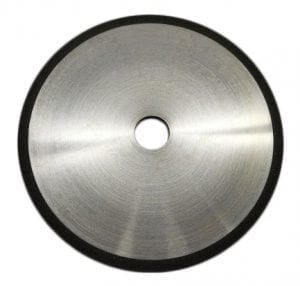
How Diamond Sharpening Wheels Works?
The superabrasive uses diamond powders affixed with a vitrified bond to a grinding wheel in order to sharpen a variety of tools.
Which Superabrasive Wheels Are Suitable for Sharpening Applications?
At Eagle Superabrasives, we manufacture two kinds of wheels that are ideal for sharpening purposes:
- Our polycrystalline diamond (PCD) wheels
- Our polycrystalline cubic boron nitride (PCBN) wheels
Both diamond sharpening wheels feature a vitrified bond system.
We mix together sintered vitreous materials with carefully selected diamond and CBN powders. As a result, a chemical and mechanical bonding of the abrasive powder to the bond structure occurs. Therefore, it minimizes diamond and CBN pull out, extending the life of the wheel. Additionally, it minimizes the chance of the wheel becoming loaded up during use.
A vitrified bond increases the tool life by over 150 times that of a resin bond. It also allows for easy truing and dressing on the machine.
What Is the Standard Grit Size of Diamond Sharpening Wheels?
A diamond sharpening wheel often uses a grit size of D22 Micron for rough grinding and D9-D6 Micron grit for super finish grinding.
At Eagle Superabrasives, we manufacture the shapes of our diamond sharpening wheels to fit 6A2 and 12A2 styles.
The core shapes are designed to be very rigid and used primarily on PDC/PCBN grinding machines like Coborn, Toyoda, Waida and EWAG, to name a few.
Diamond Sharpening Wheels – Applications
Our 6A2 PCBN wheels are ideal for knife grinding, saw grinding, edge grinding and surface grinding. They can be manufactured with diamond powder, CBN powder or a mixture of the two.
Diamond Sharpening Wheels – Characteristics
And sizes can range from 1” to 27” in diameter. Our 12A2 wheel is perfect for tool and cutter grinding, off hand grinding, face grinding and top grinding.
The diamond sharpening wheel can feature phenol, polyimide, hybrid or electro-chemical bonds, and sizes range from 2” – 16” in diameter.
Diamond Sharpening Wheels – History
A Diamond Sharpening wheel is an adequately new product among the sharpening wheels.
It was manufactured after the discovery of synthetic diamonds. As of this date, synthetic diamonds are the hardest materials used for sharpening wheels. Adding the hardest material known, to a sharpening wheel, made it an ideal superabrasive for working with non-ferrous materials. Our Diamond sharpening wheels are made of synthetic diamonds, making them extremely durable and an increased life span.
Diamond Concentrations & Performance of Sharpening Wheels
Considering that the concentration of diamond in the wheel will also benefit the wheel life and performance.
If you have an increase of diamond concentration up to 125% in the wheel, the performance of the wheel increases greatly. The higher concentration of diamond allows the pressure of each individual particle to take on its own share of pressure, causing a decrease in the overall pressure of each particle.
In the industry, this is known as the extent of hardness in the wheel. When the diamond abrasives fracture easily, it is known as a soft bond. Hard bonds can hold up to large forces due to the fracturing being restricted. You would typically use a soft wheel for surfaces that are easy to cut. Hard wheels last longer than soft and are used for finer surface finishes.
Soft vs Hard Bond Sharpening Wheels
A Diamond sharpening wheel is classified by the hardness of the wheel. The hardness of the wheel is based off on how the diamond grains are applied and how they will fracture. If the grains are designed to fracture easily the wheel is considered a soft bond. Hard bonds are used when the wheel will be applied with a large force. Surfaces that are typically easy to cut use a a soft wheel and for a finer surface finish and longer lasting wheel, hard wheels are used.
Why Choose Diamond Sharpening Wheels
Diamond Sharpening Wheels generate less heat which decreases the burns and cracks on the surface of the workpiece, and decrease equipment wear. The dimension of the wheel itself barely changes, leading to great grinding quality and high grinding precision. The lifespan of the wheel is also greater than conventional wheels, increasing the work efficiency, and improve the products labor intensity. The combination of these advantages will ensure that you save money and increase your productivity rate.
Diamond Sharpening Wheels Have an Extended Life
Diamond Sharpening wheels have shown to maintain a longer life compared to that of conventional wheels.
Diamonds are immensely durable and hard, giving the wheel a higher material removal rate.
The extent of hardness of the bond determines the life. The hardness is determined by either allowing the abrasive grains to fracture easily or by restricting the fracture.
No matter what kind of diamond sharpening wheel you’re looking for, the experts at Eagle Superabrasives can manufacture one to meet your industry’s specific needs. Contact us today!
